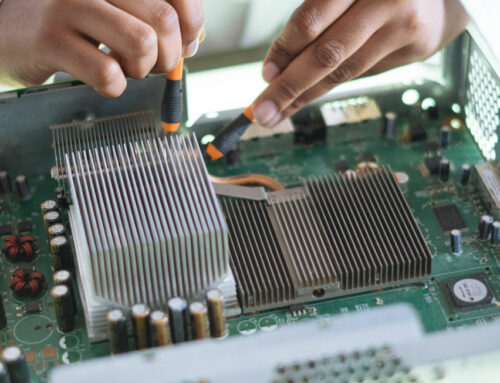Making the investment to update your networking equipment can be expensive. Coupled with the fact that you likely aren’t working with an unlimited IT budget, it can feel like an even bigger expense. This can be especially true if you’ve always purchased new equipment. Equipment that is seen as reliable, high-performing, and backed with a warranty. But did you know you can get all of those things when purchasing refurbished networking equipment? Well, you can.
The thing about networking equipment from companies like Cisco, HP, and Dell is that they create these products so well that they can and should be reused. They have a lot of life still left in them. When you purchase refurbished networking equipment, not only are you getting quality equipment, but depending on who and where you buy from, it will come with a price tag, warranty, and customer service you can feel good about.
Find out how much you can save with Summit. Request a quote.
When done properly, here is an insider’s look into what goes into the refurbishing process:
Step 1: Check for Cosmetic Issues
When the product arrives at our warehouse we examine it for any cosmetic problems, such as scratches, dents and missing parts, mounting hardware, etc… We check every inch of the unit to ensure there aren’t any issues, and if there are issues, we fix them.
Step 2: Test, Test, Test
Once the equipment is “accepted”, it is then moved into our testing lab. In the test lab, we test the equipment extensively to ensure proper function, high-performance and reliability. As we said, this type of equipment is made so well that it can and should be reused.
Step 3: Port Testing and Operating System Reset
During our refurbishing process, we then test each port to make sure power and data are passing through the board. We also return the OS (operating system) back to the factory default configuration. Note: it’s very important that we prepare the router, the switch, and other equipment so that the customer is ready to put it into their network right away.

Step 4: Replace/Repair Internal Components
While not all resellers/refurbishers take this step, we think it’s important. If there are internal components that are worn or broken, we have the ability to repair or replace them. Things like chips and PoE ports, where necessary. We ensure everything functions as the original equipment manufacturer intended it to.
Step 5: Fresh Coat of Paint
If the unit is in need of a fresh coat of paint, we find the exact color from the manufacturer and paint it. If the equipment has any other cosmetic problems, we either fix the issue or we will return it and not use it at all. It doesn’t serve us or our customers to refurbish a product that doesn’t meet our standards.

Step 6: Check Pieces and Components
The last step before the equipment goes out the door is to ensure that all the auxiliary pieces and components that are necessary for optimal performance are intact and packaged with the equipment. We want to verify that the customer has everything they need in the box upon arrival. You shouldn’t have to track down missing pieces or wait to use your equipment.
Step 7: Shipping
Finally, we take shipping our equipment as seriously as we take our refurbishing process. To ensure that the unit and components are 100% secure, we use protective packaging and ship according to UPS and FedEx specs.

While there are other, smaller steps along the way that make a big impact in the process, these are the ones that should provide the biggest insight into the refurbishing process. If you’re considering purchasing refurbished networking equipment, whether from Summit or elsewhere, make sure the equipment is thoroughly inspected, tested, checked for all necessary components, and then safely shipped.
Insider Tips When Buying Refurbished Networking Equipment
Beyond knowing that there’s a trusted refurbishing process in place, there are a few other things to keep in mind when shopping for refurbished networking equipment:
- Check the Warranty: Most new equipment comes with a warranty, but it’s typically subject to 90 days or limited lifetime warranty. The same can be said for a lot of equipment you purchase refurbished with aftermarket warranties. At Summit, we have what’s called an advanced replacement lifetime warranty, which is a true lifetime warranty. No catch. If a customer needs something two, five or ten years down the road, we replace it before they even send the unit in. Be sure to look at the type of warranty you’re getting when buying refurbished equipment and verify that it covers all your needs.
- Compare Apples-to-Apples: Perhaps you’re comparing refurbished products you found online to quotes you received from vendors. Or you’re comparing quotes between vendors. Be sure you’re comparing apples-to-apples. Meaning, there is a lot of variation in part numbers and it might not be a true comparison. It could be product X that you see for sale online, but you received a quote for product XYZ.
- Know Who’s Doing the Selling: It’s important to know where you’re getting your products from. For example, there are affiliate programs on the internet, such as with Amazon. You might find a “used Cisco switch” or piece of equipment and think it’s from Amazon, when in fact, it’s someone in their basement that signed up at $X/month to sell online. Just have an understanding of who’s supplying the item.
- Quality Customer Service: It’s possible that you’ll have questions after your purchase or maybe down the road you’ll want to purchase more equipment. It’s important to choose a vendor that has great customer service and is going to get back to you with help. Ensuring your network is in good shape is a top priority, and choosing the right refurbished networking equipment and the right vendor to supply that equipment is important. This should be a partnership, not just a purchase.

Over the last 25 years, Summit has developed our proven process that helps customers save time, money, and do more with their IT budget. If you have any questions or want to know more about refurbished networking equipment or other types of equipment, we’d be more than happy to talk.






